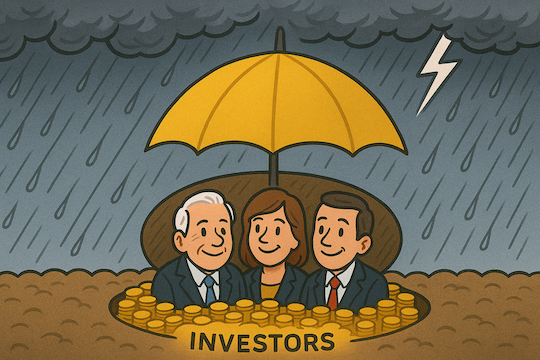
Posted August 06, 2025
By Byron King
The Next-Best Thing to Big Gold Nuggets
Wouldn’t it be nice to reach down into a stream bed and pull out a nugget like this? It might just make your day, right?

Gold nugget. Courtesy of Alaska Mint, Anchorage. BWK photo.
That’s about five ounces of gold, right there. Its purity is over 90%, meaning that overall, this item is a ball of gold alloyed with silver, plus traces of other metals like copper, tellurium, and bismuth if you’re interested.
The specimen in my hand came from a placer mining operation in central Alaska. That is, someone was out in a stream, using machinery to sift through gravel beds. And this item appeared in the wash, no doubt becoming startlingly visible as the muddy water drained away.
The backstory is that this nugget began its existence long ago, deep within the earth. It started as disaggregated metal atoms dissolved within superheated fluids. Over geologic time, and in this case somewhere in the realm of 60 million years ago, the gold and other elements crystallized out, embedded in a quartz vein which was located along a fracture plane inside a massive rock body.
Then came millions more years of geologic activity, namely uplift and erosion in the context of Alaska and its historical tale on the earth’s long timetable. And likely within the past 10,000 years, probably since the end of the last Ice Age, this shiny article weathered out of its host rock.
Over time, gravity caused the specimen to slide or drift downhill into a stream bed, where it rolled about and tumbled in the moving water, which is how it gained a visibly smooth, rounded-off look. And because gold is a relatively dense metal, water movement in the stream bed sifted out this handsome article, such that it found its way towards the bottom of the gravel layer.
Then, this sweet thing awaited its moment of discovery by some Lucky Pierre, a placer miner out in the gold fields, seeking good fortune.
This nugget made someone’s day. On the money-side, the value of the gold alone is over $16,000 at current price levels. But also consider that a large Alaska nugget like this is a rare find, which supports a markup as a collectible piece. The bottom line is that you’ll have to shell out about $30,000 if you want to take it home.
Cash Now for Payback Later
Okay, that’s a nice story about the gold nugget. But maybe you don’t live in Alaska and work as a placer miner in cold, muddy streams and rivers. Perhaps you don’t want to muck away at the bottom of gravel beds. Because frankly, that’s a super-tough job and those hardy, gold-finding souls are few.
But there’s another way for you to benefit from gold mining, and I don’t mean sifting gravel in the Yukon River basin. In fact, there’s a long-established, proven method to benefit from mining, along with the rising price of gold (and silver, plus other metals), via what are called “royalty” companies.
A royalty company is like a gold mining company… but without the actual gold mining. Or perhaps it’s more accurate to say that a royalty company is similar to a highly specialized lending bank, namely one that provides money to mining plays at varying stages of life, with payback out of eventual metal and/or income stream from whatever the mine produces.
For example, let’s say that Company XYZ is working on an exploration project. Out in the field, things are promising, but management needs more funds to complete its drilling program. It takes money to identify and verify a resource base, but no conventional bank lends money for such projects because they are too speculative. So, there’s no traditional bank loan, and maybe the XYZ share price is down, too, and raising capital via new shares will dilute existing shareholders. What else is there?
In this case, XYZ management might make a deal with a royalty company. And of course, every deal has differences and nuances. Still, in essence, the royalty company will front XYZ with a cash infusion, in return for a future payback out of mine proceeds, or even future delivery of metal from the mine.
The heart of this kind of deal is that XYZ will now have cash with which to advance the project. Then later, likely years down the line, XYZ will pay a cash stream to the royalty company, if not deliver actual metal. Generally, based on the history of inflation in commodity prices and values, the future cash and/or metal will have a value far higher than the original up-front payout by the royalty company. (As in, yes, the royalty people are in the business of getting their money back!)
Of course, there’s risk here. What if XYZ never makes the exploration project work? Well, the royalty company won’t get repaid, and that’s a key risk in the business model. Thus, royalty companies scrutinize the heck out of their clients and then monitor developments like a hungry hawk. To this end, royalty companies employ or retain geologists, engineers, accountants and others with particular skillsets to oversee their deals.
This royalty idea works at other phases of the mining business cycle as well, not just exploration. For example, let’s say that Company ABC already has a great discovery, but now needs funds for development. Again, most conventional banks won’t touch mine development, and perhaps there’s little desire by the developer to issue new shares and dilute the previous holders. So, ABC might deal with a royalty company; management will obtain a whack of cash now, for payback or a metal stream in the future.
Carrying on with the explanation, even producing mines deal with royalty companies. Yes, a mine might be up, running, and flowing cash. But perhaps the company needs new capital for expansion, or to deal with an emergent need to solve some other problem. Again, the royalty company fronts the funds, in return for a future payback in cash or metal.
If all of this sounds like a forward-looking business sector, in which royalty companies must think several years and even decades ahead, then you’re getting the idea. Most exploration projects require years to come to fruition in discovery; and most discoveries require many more years to develop into a mine. But once a project is up and running, most mines have a productive life of many years, often decades and more; and that long-term royalty or metal stream will add up handsomely down the road.
Once a royalty company is up and running, and time has passed for its early deals to mature, the cash begins to flow steadily. And now in 2025, when we’re clearly in a strong, rising market for gold, silver, copper, and much else, many of the previous estimates of future value are paying off like gangbusters for royalty plays.
Plus, note that in all this discussion of the business model, one key aspect is that the royalty company avoids what’s called “operational risk.” Yes, royalty companies put money on the table, but they don’t do the actual work to explore, develop or operate mines. They don’t have labor issues, or worry (too much) about the price of diesel fuel, etc. They are in the business of getting paid based on current metal prices, or taking claim to metal, again at current price levels. And when gold or silver prices rise, it’s fair to say that the upside benefit hits early and big-time on the bottom lines of royalty companies.
How Golden Dreams Come True
Let’s consider some examples of royalty companies that have done quite well, along with other names that are up-and-comers.
One famous name in royalty companies is Franco Nevada Corp. (FNV), which boasts a market cap of over $31 billion. Since 2019, shares have moved from the $60 range to the current level over $160. This is based on literally hundreds of royalty contracts that FNV has with mining plays across several continents; some still in early stages, but other claims now paying off handsomely after a patient wait.
Another great royalty name is Wheaton Precious Metals (WPM), with a market cap over $43 billion, and share price in the range of $95. The company is superbly managed, with low overhead, and is growing well. Again, like with FNV above, in a generally rising environment for gold and silver over the past few years, the share price for WPM has more than tripled.
I like FNV and WPM, but both are big plays, and the shares are pricey. Looking ahead, both companies are likely to grow if for no other reason than their royalty income and metal streams are higher in value. Plus, with their currently strong share price, both companies can grow by buying other companies, rather than making long-term royalty deals.
In this last sense, it may be better to be a company that’s being bought. And we’re currently seeing mergers and acquisitions in this sector, such as the recent deal between Royal Gold (RGLD) and Sandstorm (SAND).
Along these same lines, I like Osisko Royalties Inc. (OR), with a market cap of over $5 billion and a share price in the $28 range.
OR was founded by a dynamic, hard-charging Canadian mining engineer named Sean Roosen, one of whose claims to fame was developing the Canadian Malartic Mine, in Quebec, currently the largest gold mine in Canada. Then in 2014, Sean sold Malartic to Agnico Eagle Mines (AEM), but retained a royalty that pays into OR. And right away OR benefits long-term from a large, continuing royalty income from just this one mine alone.
Now add that fact that OR has been aggressive and successful in picking up other royalty plays in North and South America, Africa and Australia. In this respect, OR is a well-run, stand-alone royalty name. But it’s also “small” enough, in a manner of speaking, to be takeover bait for a much larger company, which may want something to move its own needle.
Thus, with OR, you have a solid royalty base for organic growth, as well as takeover upside possibilities down the line.
Another smaller, but superb quality royalty company is Empress Royalty Corp. (EMPYF), market cap $80 million, with shares trading on the OTC board in the $0.65 range. The company’s share price has doubled just in 2025, based on strong cash flow, with an impressive string of new deals by management. Looking ahead, the Empress cash flow should remain strong, with upside in a rising price environment for gold and silver. And then there’s the takeout or takeover angle, where a larger company might swoop in.
Both Osisko Royalties and Empress are great names and solid plays, worthy of a gold-oriented portfolio. Note, though, that these names are not official recommendations to the portfolio. But they’re great companies in their own way, and I follow them. If you buy shares, wait for down days in the market, always use limit orders and never chase momentum!
Wrap-Up
Going back to the beginning of this note, it sure would be nice to have a big, hefty gold nugget pop out in the gravel wash. But again, you don’t live in Alaska or make your living out in the streams and rivers, dredging and panning for gold.
Still, you can benefit from the current lift in gold prices, which at root reflects the declining purchasing power of the dollar. One of the best ways to preserve and increase your own wealth, and to gain exposure to rising metal prices, is with royalty plays. These range in size from really big to relatively small, and any portfolio with precious metals ought to hold a couple of the names I laid out here.
That’s all for now. Thank you for subscribing and reading.

A Money Pit That Saved Investors?
Posted August 29, 2025
By Byron King

A Philosophy For Living
Posted August 28, 2025
By Sean Ring

The Crowd’s Madness Saves Uncle Herschel
Posted August 27, 2025
By Sean Ring

The Fed's Cook is Goosed
Posted August 26, 2025
By Sean Ring

The Ascent of Ag in 5 Tweets
Posted August 25, 2025
By Sean Ring
